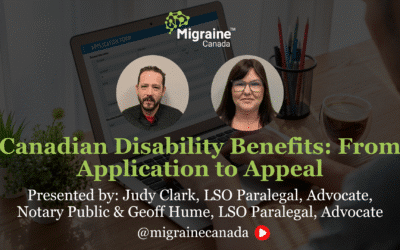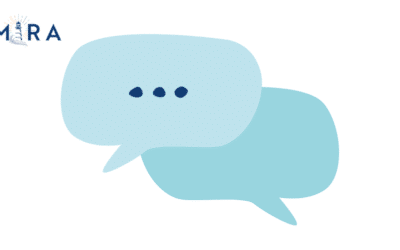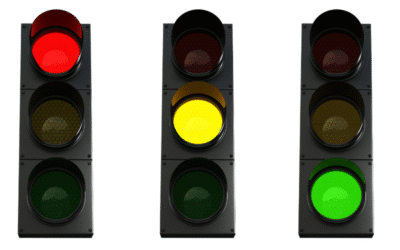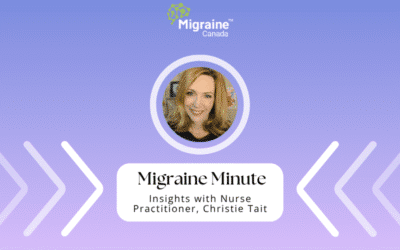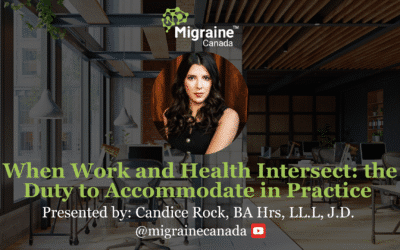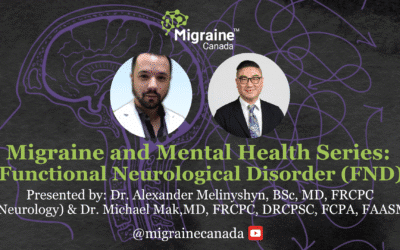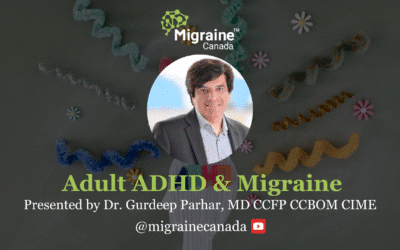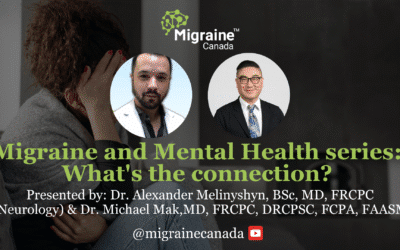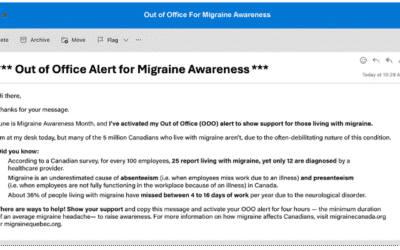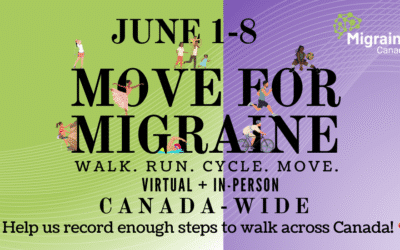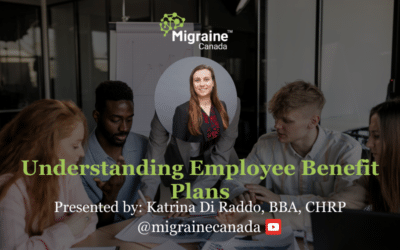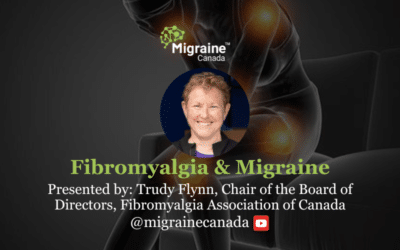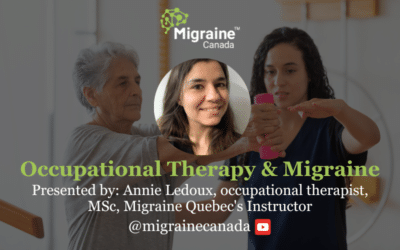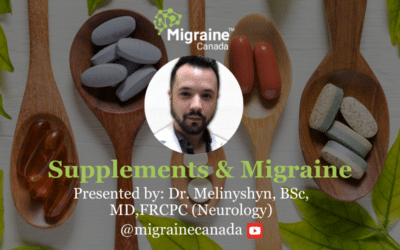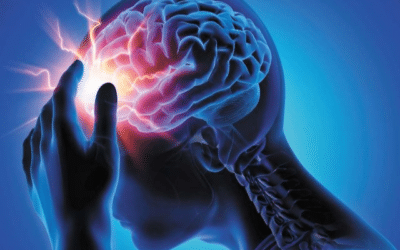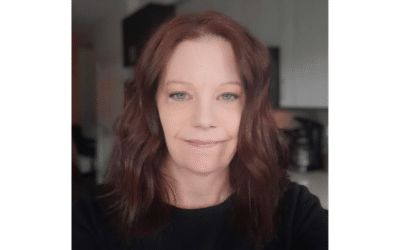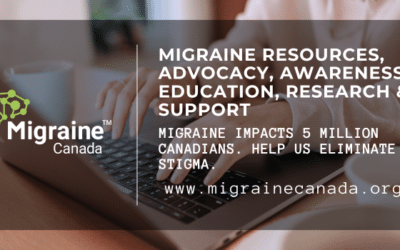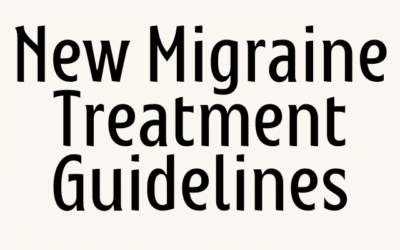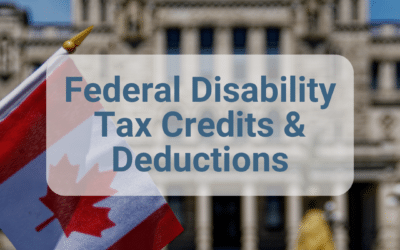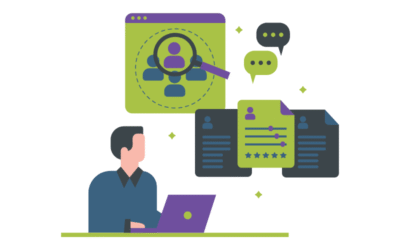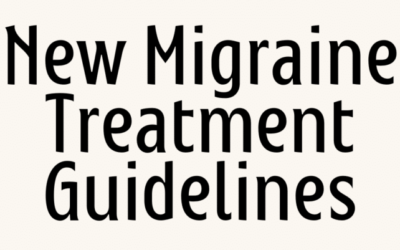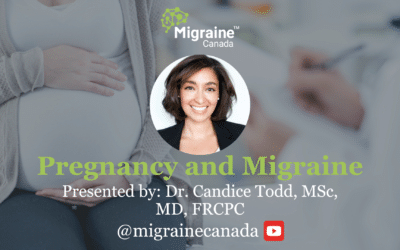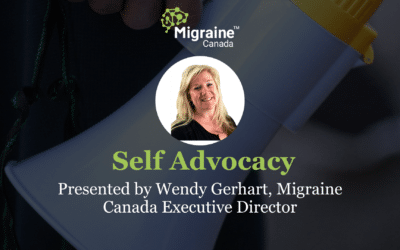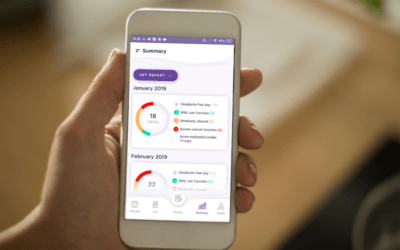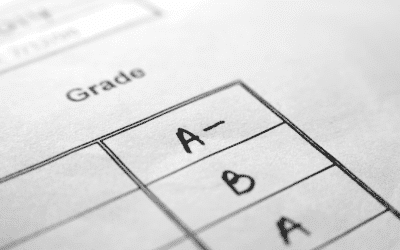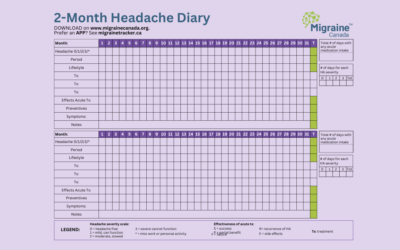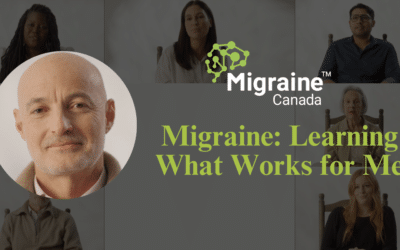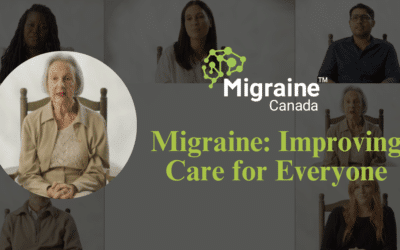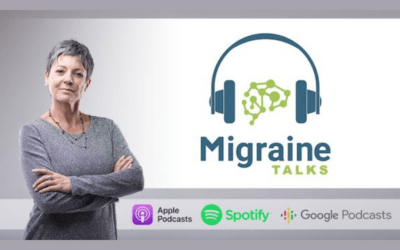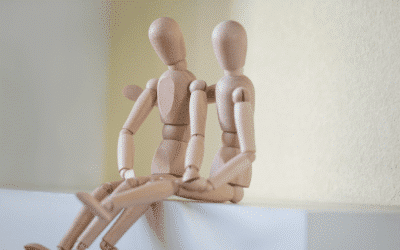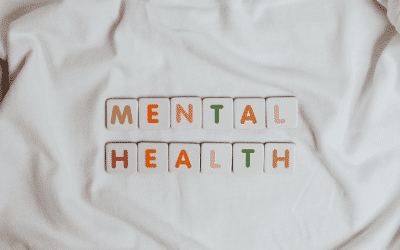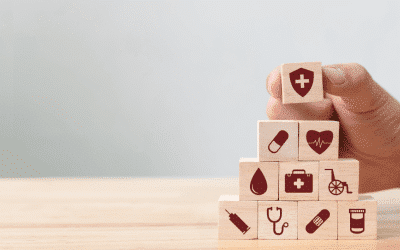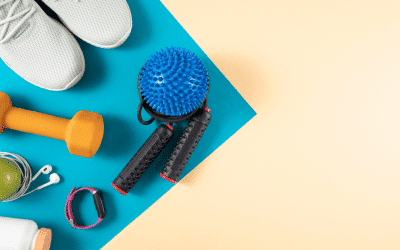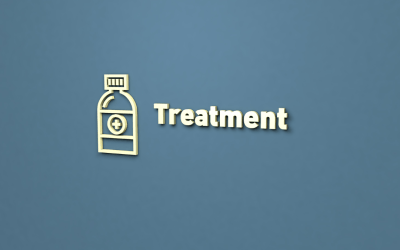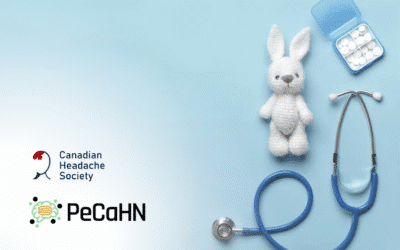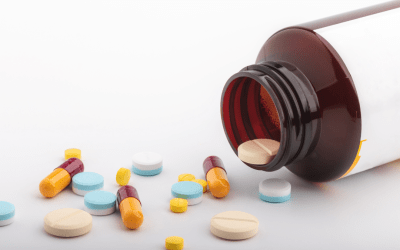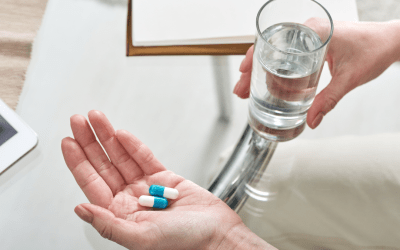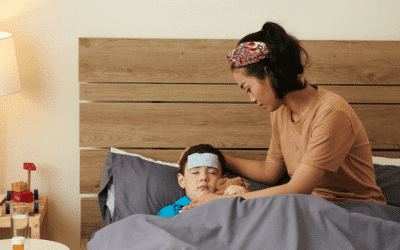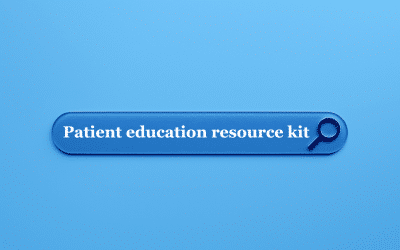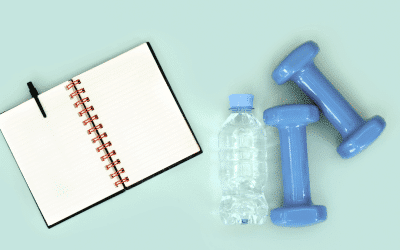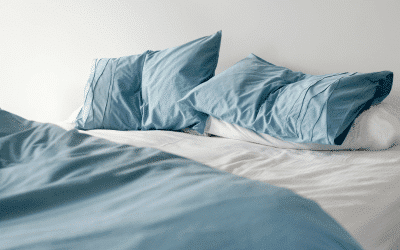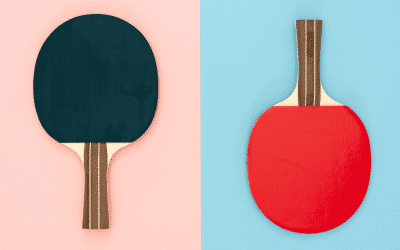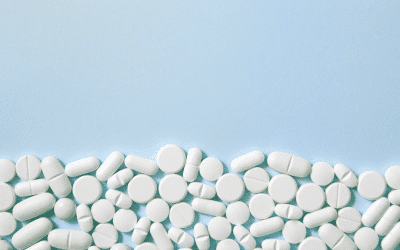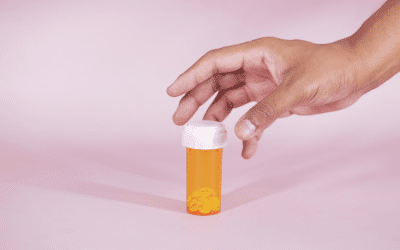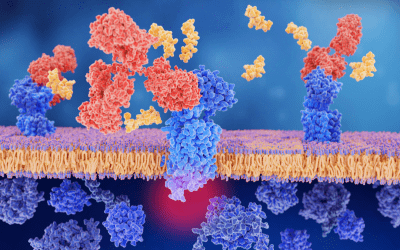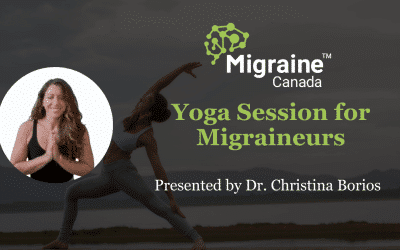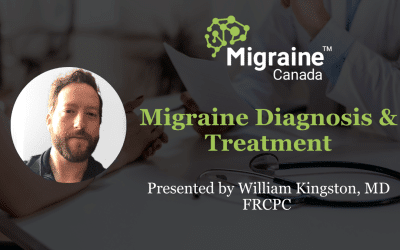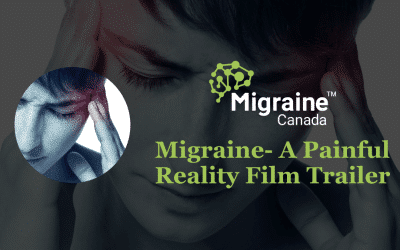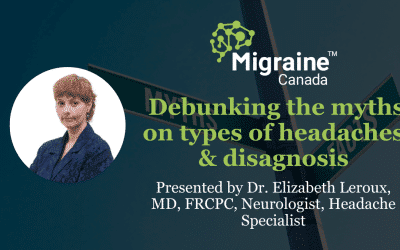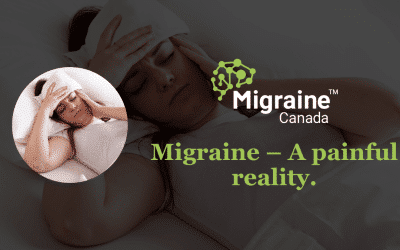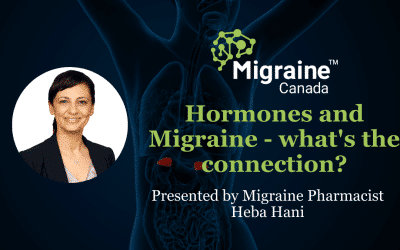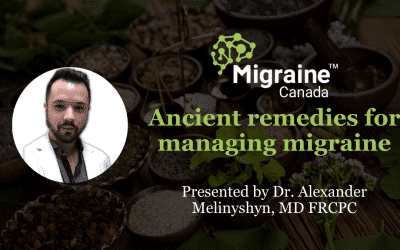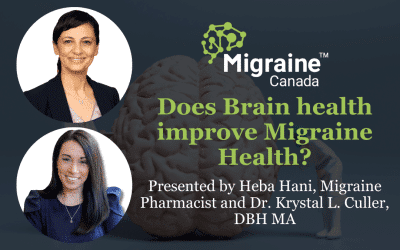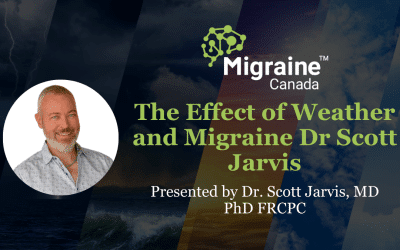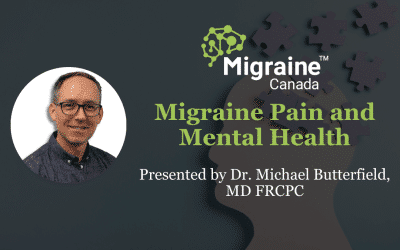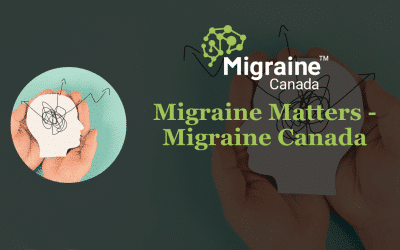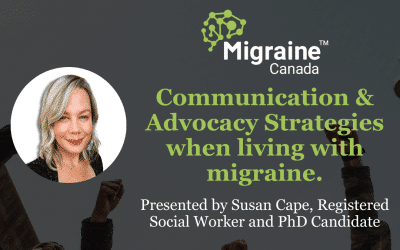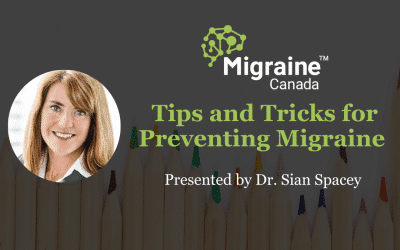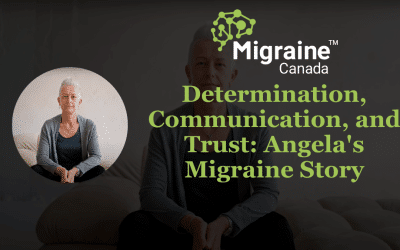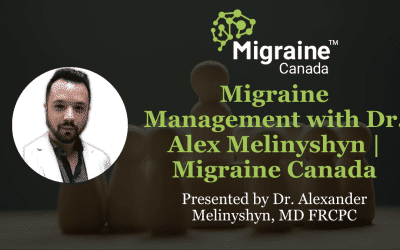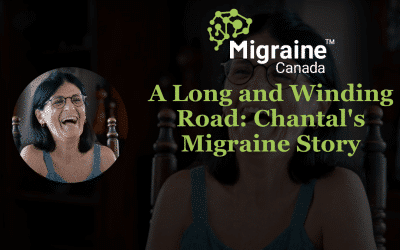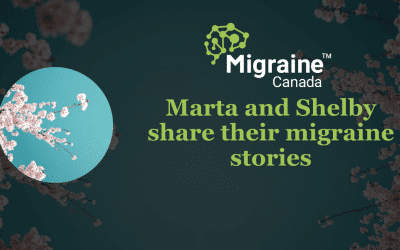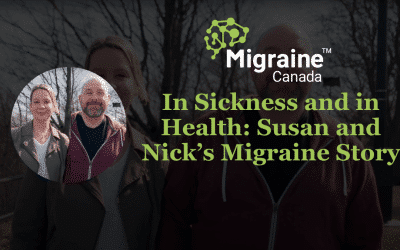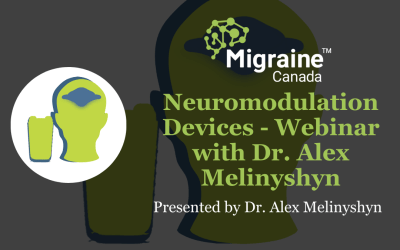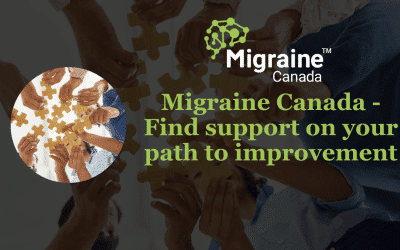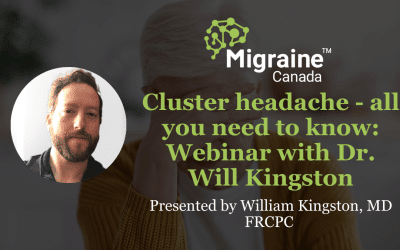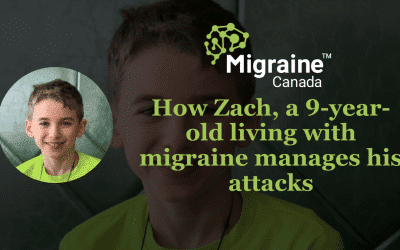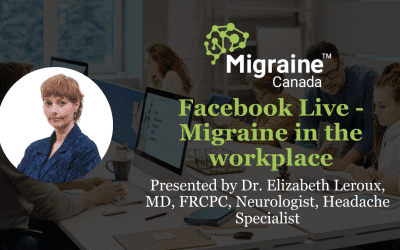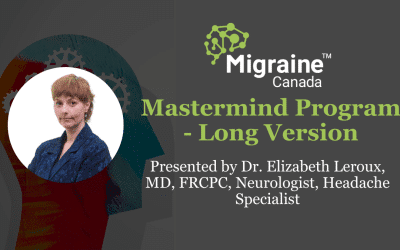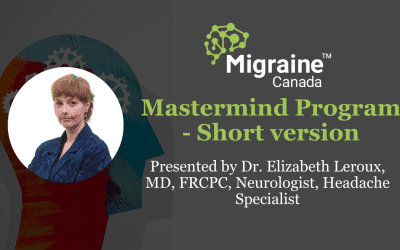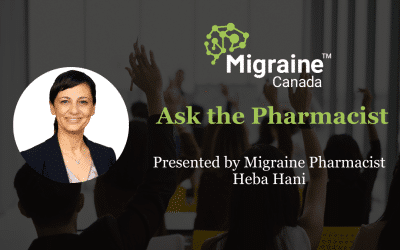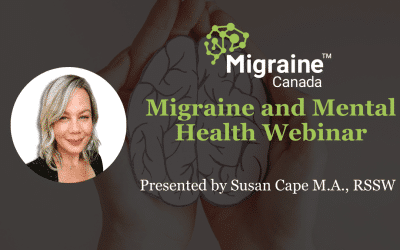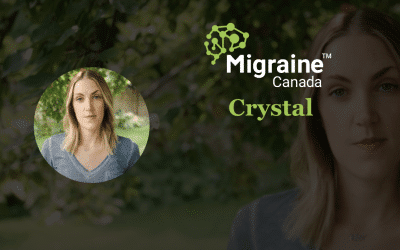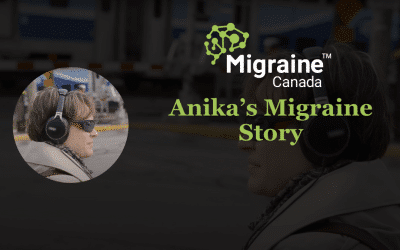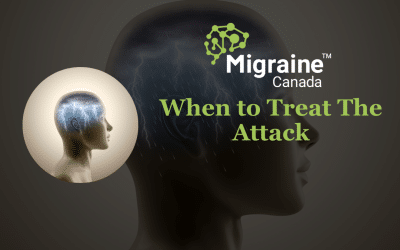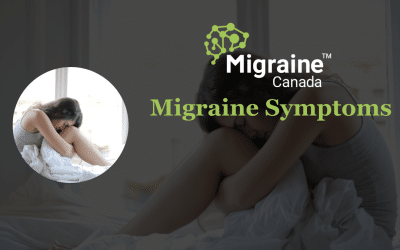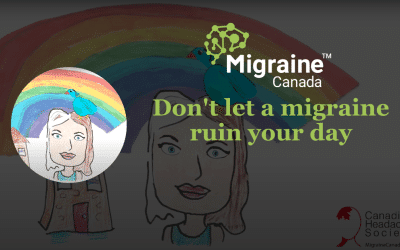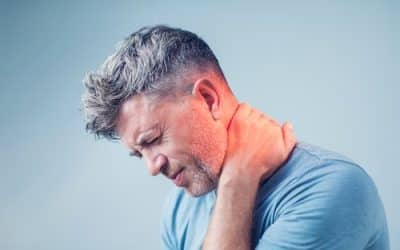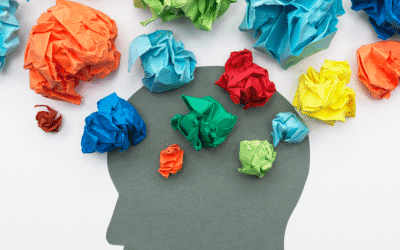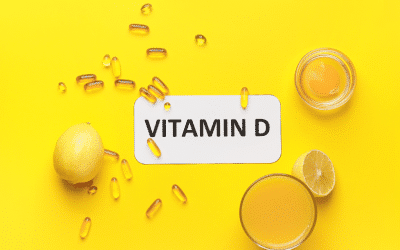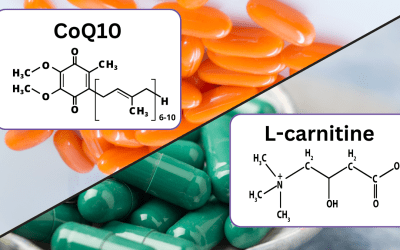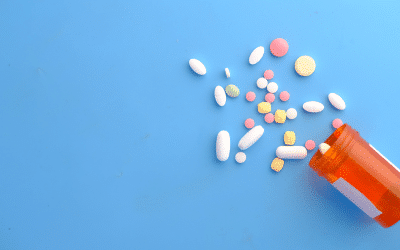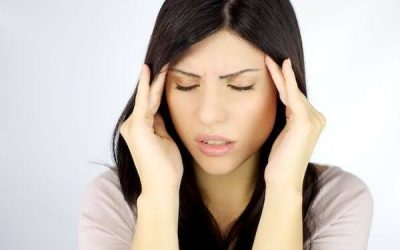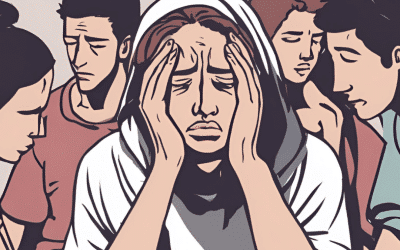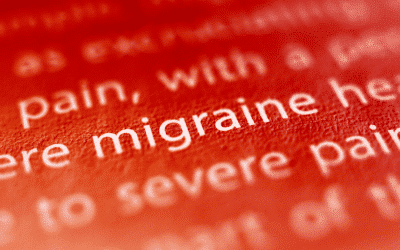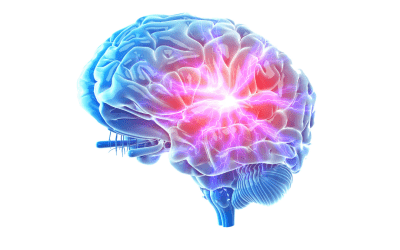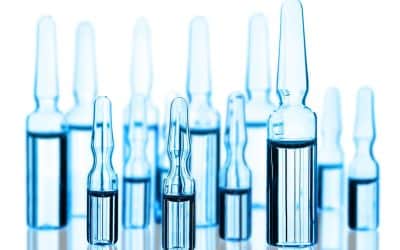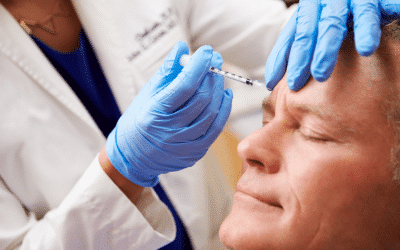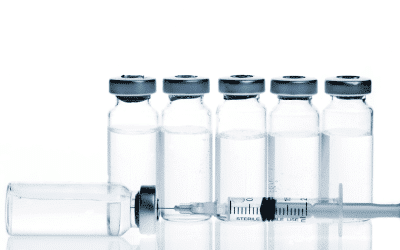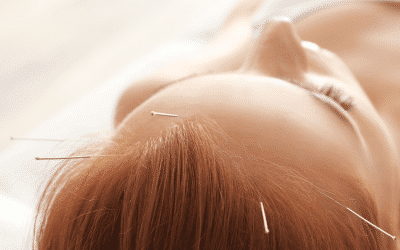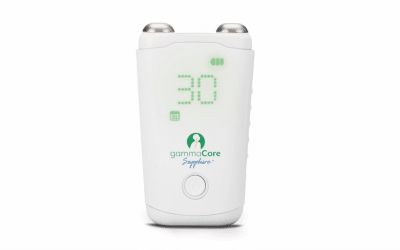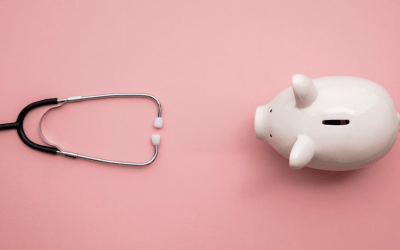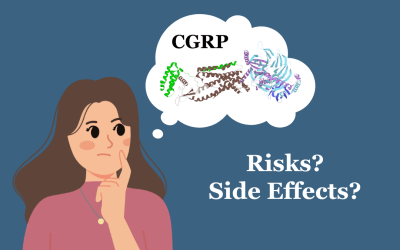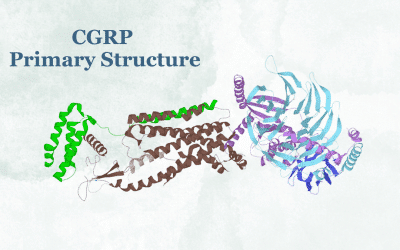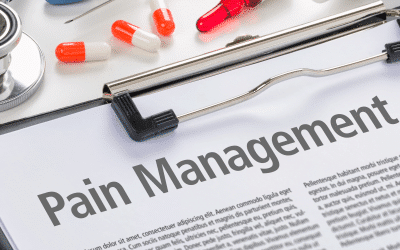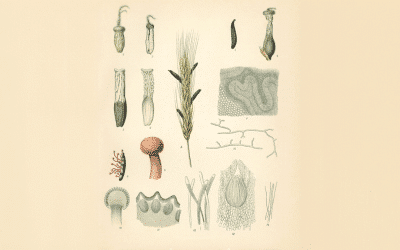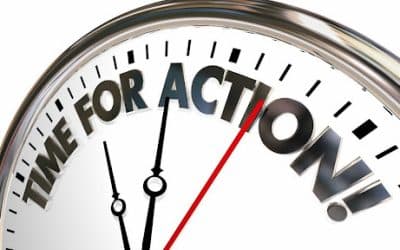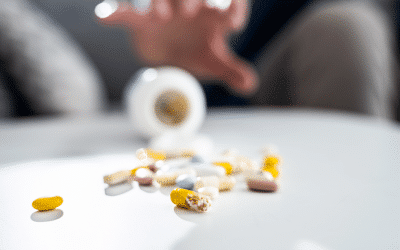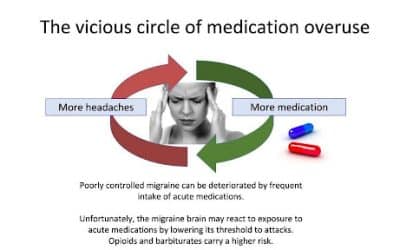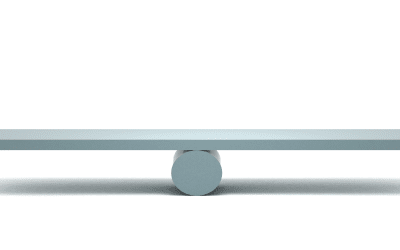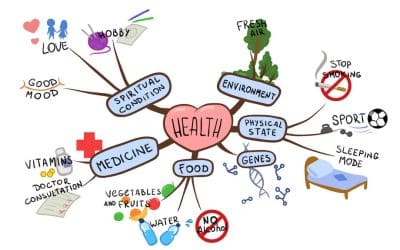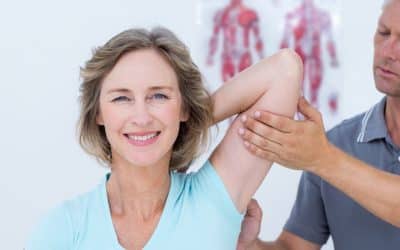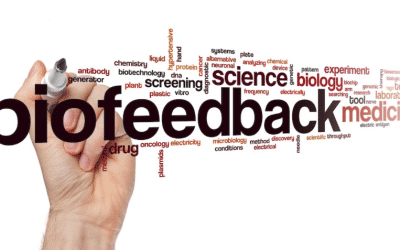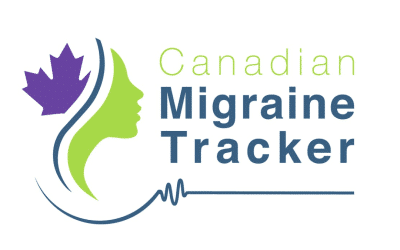Episodic Migraines
A Season of Support for Migraine Canada
Together, We're Changing the Migraine Story Thank you for your incredible support and contributions throughout 2025.This year, we’ve made meaningful progress toward our mission. Supporting Canadians living with migraine, by offering free resources, programs, tools,...
Giving Tuesday
Together we can bring visibility to MigraineOn Giving Tuesday, small actions add up to big impact. Your contribution today helps us expand vital programs, reach underserved communities, and continue to build a future where every Canadian with migraine has access to...
Canadian Disability Benefits: From Application to Appeal Webinar
Canadian Disability Benefits: From Application to Appeal Webinar Recording Learn about the key Canadian programs like CPP Disability, ODSP, and OW. Whether you’re preparing to apply, facing a denial, or considering an appeal, learn what support and legal resources are...
MIRA: The Mental Health Virtual Assistant
Questions about mental health?Meet MIRA. If you’re seeking mental health information, support, or services, MIRA (Mental health Intelligent information Resource Assistant) is here to help. MIRA is a free chatbot powered by artificial intelligence and machine learning,...
Patient Support Program Information for Migraine Treatment
Need Help with Coverage or Financial Support for Your Migraine Medication? If you’re living with migraine and struggling to afford your treatment, Migraine Canada is here to help guide you. We’ve compiled a helpful list of Patient Support Programs (PSPs) available in...
Model of Care for Migraine in Canada
People living with migraine in Canada often struggle with inconsistent and fragmented care. Access to treatment and support varies widely depending on where a person lives, which provider they see, and what resources are available. This patchwork approach leaves many...
FAQ sur les avantages sociaux des employés : Guide complet sur les assurances collectives, la couverture maladie, l’invalidité et les mesures d’accommodement en milieu de travail
Cette FAQ complète sur les avantages sociaux des employés est une ressource supplémentaire du webinaire de Migraine Canada : « Comprendre les régimes d’avantages sociaux des employés », présenté par Katrina Di Raddo (BBA, CRHA). Il est conçu pour aider les employés à...
Employee Benefits FAQ: Guide to Group Benefits, Health Coverage, Disability, & Workplace Accommodations
This comprehensive Employee Benefits FAQ is a supplementary resource to the Migraine Canada webinar: "Understanding Employee Benefit Plans", presented by Katrina Di Raddo (BBA, CHRP). It is designed to help employees understand and navigate group benefits and claim...
Connaissez vos droits: L’obligation d’accommoder
Connaissez vos droits : L’obligation d’accommoder – Ce que les travailleurs doivent savoir Si vous souffrez d’un problème de santé ou d’un handicap qui affecte votre capacité de travailler, il est important de connaître votre droit à obtenir des mesures...
The Migraine Traffic Light System: A Simple Way to Track Headache Severity
If you have migraine, it can be challenging to explain just how much your daily life is impacted. That’s where the Traffic Light System for Migraine Severity comes in, a straightforward, colour-coded way to assess how disabling a migraine attack is, and to guide...
Duty to Accommodate in the Workplace – PDF resource
Know Your Rights: The Duty to Accommodate – What Workers Need to Know Understanding the Duty to Accommodate is essential if you have a health condition or disability affecting your ability to work. This duty requires employers to provide reasonable adjustments. These...
Migraine Minute with Nurse Practitioner Christie Tait
Migraine Minute: Your Quick Guide to Migraine Management What is Migraine Minute?Migraine Minute is a popular short-form video series focused on migraine management. Hosted by Nurse Practitioner Christie Tait, Migraine Minute delivers clear, evidence-based migraine...
What Canadians Living with Migraine Want You to Know: Key Messages from Our Quality of Life Survey
Author(s): Dr. Elizabeth Leroux
Published In: 67th Annual American Headache society Scientific Meeting
Summary: The poster objectives are to share a qualitative analysis of data from 1119 Canadians living with migraine who shared key messages and advice they would direct to three sets of stakeholders: young people beginning their migraine journey, healthcare professionals who care for people living with migraine and to policy makers via an online survey.
When Work and Health Intersect: the Duty to Accommodate in Practice
Duty to Accommodate in the Workplace Webinar: When Work and Health Intersect The Duty to Accommodate in the Workplace Webinar offers essential guidance on how employees, employers, and healthcare providers can work together to support workers with health challenges....
Migraine & Mental Health: Functional Neurological Disorders
Functional Neurological Disorders WebinarPresented by Dr. Alexander Melinyshyn, BSc, MD, FRCPC (Neurology), and Dr. Michael Mak, MD, FRCPC, DRCPSC, FCPA, FAASM This Functional Neurological Disorders Webinar explores the complex relationship between migraine and mental...
Adult ADHD & Migraine
Adult ADHD & Migraine WebinarPresented by Dr. Gurdeep Parhar, MD CCFP CCBOM CIME Watch a recording of our webinar on adult ADHD and its relationship to migraine, presented by Dr. Gurdeep Parhar. This session explores how ADHD presents in adulthood, how it may...
Migraine & Mental Health
Migraine & Mental Health: What's the Connection? Presented by Dr. Alexander Melinyshyn, BSc, MD, FRCPC (Neurology) & Dr. Michael Mak, MD, FRCPC, DRCPSC, FCPA, FAASM In this webinar recording, Dr. Melinyshyn and Dr. Mak explore the important connection between...
Person-Centric Communication in Migraine
Migraine Canada participated in a project with other organizations from around the work and key stakeholders to gain a better understanding of Patient Centric Communications. The Primary objectives included: Examining how Healthcare providers and people with migraine...
Migraine Awareness Month 2025 – Interviews with Dr. Will Kingston
Migraine Canada Featured on CTV News and Global News for Migraine Awareness Month Migraine Canada was recently featured on CTV News and Global News in two segments dedicated to raising awareness for migraine. We were proud to help facilitate this important opportunity...
Living with Migraine: Emily’s Story
Life with Chronic Migraine: Emily's StoryMigraine is a complex neurological disease that affects over 5 million Canadians. For those living with chronic migraine, the impact goes far beyond head pain—it can interfere with work, relationships, education, and mental...
Migraine Guide de Discussion
La gestion de la migraine commence ici : un guide de discussion pour vous préparer à votre rendez-vous avec votre médecin de famille La migraine est une maladie neurologique complexe dont la fréquence, la gravité et l’impact varient, ce qui en fait une expérience...
Migraine Awareness Month – Out of Office
Join us in raising awareness for migraine in the workplace To mark Migraine Awareness Month this June 2025, Migraine Canada, along with Migraine Quebec and Pfizer Canada is supporting Out of Office for Migraine Awareness, a national campaign that continues to raise...
Move for Migraine Press Release
Migraine Canada Announces Fourth Annual Move for Migraine Event to Combat Migraine Stigma and Support Affected Canadians Migraine Canada™ is proud to announce the return of its fourth Move for Migraine event taking place from Sunday, June 1 to Sunday, June 8, 2025,...
Migraine Discussion Guide
Migraine Management Starts Here: A Migraine Discussion Guide to Prepare for Your PCP Appointment Migraine is a complex neurological disease that varies in frequency, severity, and impact, making it a highly individual experience. With the right support and treatment...
Why Does My Migraine Feel Different on Weekends vs. Weekdays?
If you’ve ever noticed that your migraine attacks seem to be more frequent or intense on weekends, you’re not alone. Many people with migraine experience this pattern, and there are a few key reasons why it happens. Common Weekend Migraine Triggers Caffeine Timing...
Dustin’s Experience with Cluster Headache
Hear from Dustin as he shares his first cluster headache experience, what his cluster headache cycles are like, how cluster headache impact his life, his coping strategies, what he would say to other cluster headache patients and caregivers, and an important message...
Understanding Employee Benefit Plans
Presented by Presented by Katrina Di Raddo, BBA, CHRP. Katrina Di Raddo is deeply passionate about advancing human rights and advocating for healthcare. Her dedication to these causes drives her to make a meaningful impact, supporting initiatives that promote fairness...
Fibromyalgia & Migraine
Presented by Trudy Flynn, Chair of the Board of Directors, Fibromyalgia Association of Canada. Learn about fibromyalgia symptoms, causes, diagnosis challenges, treatment options, and strategies for managing daily life with both migraine and fibromyalgia. Trudy Flynn...
Occupational Therapy & Migraine
Explore how occupational therapy (OT) can support people living with migraine. This video covers the role of OT in identifying triggers, managing energy, adapting routines and environments, and building personalized strategies for prevention and recovery. Learn practical techniques and how OT fits into a comprehensive migraine care plan.
Supplements & Migraine
Supplements for Migraine Treatment, Prevention, & Management Supplements for Migraine Management can play a meaningful role in a holistic approach to preventing and managing migraine. In this educational session, Dr. Melinyshyn, BSc, MD, FRCPC (Neurology),...
Canadian Laws Surrounding Disability Accommodations
Migraine Canada has created a document that outlines disability accommodations in workplaces and schools, focusing on pain-related disabilities like migraine. It covers legal protections under Canadian laws, including the Accessible Canada Act (ACA) and the Canadian...
Cluster Headache Awareness Day
March 21 is Cluster Headache Awareness Day. Cluster headache is one of the most intense and debilitating headache disorders, yet it remains widely misunderstood and under-diagnosed. Those affected often experience excruciating pain in recurring cycles, significantly...
Cluster Headache Awareness – Bridget Cucksey’s Story
Bridget Cucksey served in the military for 16 years. In 2010, while deployed in Afghanistan, Bridget started experiencing cluster headaches and migraine attacks in 2010. Initially presenting as occasional headaches, by 2018 they had become chronic. Bridget’s pain...
Migraine Canada in the News: Dr. Melinyshyn on New Canadian Guidelines
Migraine Canada’s Medical Advisory Committee member, Dr. Alex Melinyshyn, was recently featured in Healthing.ca to discuss the newly updated Canadian guidelines for migraine treatment and prevention. In this interview, Dr. Melinyshyn dives deeper into why these...
Your Voice – Kimberley’s Migraine Story
In this article, Kimberley B. of Alberta shares her story of living with vestibular migraine. Kimberley’s experience is complex and multifaceted, with aura and cervicogenic headaches. Here’s a glimpse into her life as she struggles with a debilitating condition...
Migraine Canada – National Women’s Show 2025
Migraine Canada is excited to be part of the National Women’s Show in Calgary on April 5-6, 2025! If you’re visiting us from the show, welcome. We are dedicated to providing trusted migraine education, resources, and support to help you take control of your health....
Ramadan & Migraine
In 2025, Ramadan is expected to start in the first week of March (based on the lunar calendar). Fasting during Ramadan is one of the five pillars of Islam. Muslims fast from pre-dawn until either sunset or end of twilight. In Canada this year, the fasts will range...
New Canadian Migraine Treatment Guidelines
The Canadian Headache Society has released its New Canadian Migraine Treatment Guidelines, featuring the latest evidence-based recommendations to enhance migraine care. These updated Migraine Prevention Guidelines provide healthcare professionals and patients with...
Federal Disability Programs, Benefits, and Credits
The Government of Canada has many programs to help you supplement your sources of income if you're living with a disability. These include disability pensions, children’s benefits, savings plans and more. You may be eligible to get disability benefits from different...
Federal Disability Tax Credits and Deductions
Many tax credits and deductions are available for people living with a disability - https://www.canada.ca/en/revenue-agency/services/tax/individuals/segments/tax-credits-deductions-persons-disabilities.html Website...
Federal Insurance Benefits When Living with a Disability
Different types of insurance benefits may help you cover expenses when you’re living with a disability. These benefits may include the following. Website: https://www.canada.ca/en/financial-consumer-agency/services/insurance/disability.html About This Benefit An...
Self-management recommendations: using the seeds approach.
Managing migraines effectively starts with a holistic approach, and the SEEDS method—Sleep, Exercise, Eat, Diary, and Stress—offers a simple yet powerful way to take control of your symptoms. By prioritizing quality sleep, maintaining regular physical activity,...
Navigating Migraine and Headache Care in Canada: A Resource Guide
Navigating Migraine & Headache Care in Canada: A Resource Guide For Canadians managing migraine, navigating migraine & headache care in Canada is essential. Finding effective healthcare support requires understanding available options and identifying which...
How to Prepare for a visit to the Emergency Department
Effectively managing migraines often involves taking steps to avoid hospital visits whenever possible.Speak with your healthcare professional (HCP) about acute medications you can take during a migraine attack to reduce the likelihood of needing a trip to the...
A Guide for Attending Appointments Virtually (by video or phone)
Telemedicine is transforming healthcare, allowing patients to connect with healthcare professionals (HCPs) efficiently and conveniently from the comfort of their homes. With more HCPs adopting telemedicine, virtual appointments by video or phone have become an...
Migraine Healthcare Provider (HCP) Appointment Checklist
Effectively managing your migraine begins with clear communication with your healthcare provider (HCP), whether that’s your doctor or nurse practitioner. Our HCP Appointment Checklist is designed to help you make the most of your medical visits by guiding you through...
Updated Headache Guidelines and Their Impact on Canadians
Advancing Migraine Care: Updated Headache Guidelines and Their Impact on CanadiansPresented by: Dr. Elizabeth Leroux, MD, FRCPC, Neurologist, Headache Specialist This webinar will delve into understanding the newly released Canadian headache guidelines and their...
Pregnancy and Migraine
Pregnancy and MigrainePresented by: Dr. Candice Todd, MSc, MD, FRCPCReview key adjustments for managing migraine before pregnancy and understand how migraine may evolve during this time. We will also cover the safest treatments for migraine attacks during each...
Self Advocacy
Presented by: Wendy Gerhart, Migraine Canada Executive DirectorLearn about the key role of self-advocacy in patient care. Discover how patients can take an active role in their treatment and get tips on preparing for discussions with healthcare providers. Also, check...
Nunavut Disability Programs, Benefits, and Credits
About This Program The Income Assistance Program is a program of last resort intended to help Nunavut families and individuals meet their basic needs when for various reasons, including disability, illness, low-income or periods of unemployment, they are unable to...
Northwestern Territories Disability Programs, Benefits, and Credits
Learn more about the Northwest Territory's disability programs, benefits, and credits including: Services for Persons with Disabilities Extended Health Benefits for Specified Disease Conditions Program Income Assistance for Seniors and Persons with Disabilites Senior...
Yukon Disability Programs, Benefits, and Credits
Learn more about Yukon's Disability Programs, Benefits and Credits including: Chronic Disease and Disability Benefits Program Chronic Conditions Support Program Children's Disability Services Website:...
Nova Scotia Disability Programs, Benefits, and Credits
Website: https://novascotia.ca/coms/employment/income_assistance/index.html About This Program: The Income Assistance (IA) program helps you when you are not able to support yourself or your family. Depending on your situation, you may get money for your basic...
Prince Edward Island Disability Programs, Benefits, and Credits
The Department of Social Development and Seniors - https://www.princeedwardisland.ca/en/topic/social-development-and-seniors The Department of Social Development and Seniors supports Islanders most in need and helps promote resiliency through community partnerships...
New Brunswick Disability Programs, Benefits, and Credits
Website: https://www2.gnb.ca/content/gnb/en/departments/social_development/services/services_renderer.200972.Disability_Support_Program.html About This Program: The Disability Support Program (DSP) provides personalized, flexible supports for adults with...
Newfoundland and Labrador Disability Programs, Benefits, and Credits
Website: https://www.gov.nl.ca/hcs/prescription/ About This Program: The Newfoundland and Labrador Prescription Drug Program (NLPDP) provides financial assistance for the purchase of eligible prescription medications for those who reside in the province. There...
Quebec Disability Programs, Benefits, and Credits
People with disabilities - https://www.quebec.ca/en/people-with-disabilities See the programs, measures and services for people with disabilities, their families and their caregivers. Information and support services for people with disabilities -...
Ontario Disability Programs, Benefits, and Credits
Website: https://www.ontario.ca/page/ontario-disability-support-program About This Program: ODSP offers: money to help you and your eligible family members with living expenses, including food, and rent health benefits, including prescription drugs and vision...
Manitoba Disability Programs, Benefits, and Credits
Website: https://www.gov.mb.ca/fs/manitobasupports/index.html About This Program: Effective April 1, 2023, Manitobans living with severe and prolonged disabilities are invited to apply for Manitoba Supports for Persons with Disabilities. People from all over...
Saskatchewan Disability Programs, Benefits, and Credits
Learn more about Saskatchewan's disability programs, benefits, and credits including: Saskatchewan Assured Income for Disability (SAID) Saskatchewan Aids to Independent Living (SAIL) People with Disabilities -...
Alberta Disability Programs, Benefits, and Credits
Learn more about Alberta's disability programs, benefits, and credits including: Alberta Aids in Daily Living (AADL) Assured Income for Severely Handicapped (AISH) Alberta Grant for Students with Disabilities People with disabilities -...
Summer Camp Checklist
Hat? Check! Sunscreen? Check! Bathing suit? Check! You may already have a standard summer camp packing list, but if your child experiences migraines, you’ll want to ensure they’re set up for a comfortable, safe, and fun camp experience. Review our summer camp...
Canadian Migraine Tracker App
The Canadian Migraine Tracker App was designed hand-in-hand with Canadian neurologists, primary care providers, patients and advocates. It is easy to use and expertly designed, giving your provider the right information in the right way so you can get the help you need.
Burden of Migraine : Quality of Life Report
In 2021, Migraine Canada launched the Quality of Life survey to gain insight into the impact of migraine on daily life and the specific needs of Canadians living with this condition. The findings offer invaluable data that guide our programs and resources. We extend...
Migraine in Canada: Report Card on Access to Care and Treatment
Migraine is a leading cause of disability in Canada, yet people with migraine and related headache disorders face significant barriers to accessing quality care and treatment. Migraine Canada’s Report Card on Access to Care and Treatment for Migraine in Canada...
Printable Migraine Diary Templates
A migraine diary is an essential tool for anyone managing migraine. Migraine Canada’s printable diary templates are designed to help track important details like timing, duration, intensity, and possible triggers of each migraine episode. By consistently using a...
British Columbia Disability Programs, Benefits, and Credits
Learn more about the British Columbia disability programs, benefits, and credits including: Disability Assistance Endowment 150 Grant B.C. Access Grant for Students with Disabilities Services for people with disabilities...
Mental Health and Health Support Hotlines
National Hotlines for Immediate Help in Canada Migraine Canada has compiled a comprehensive list of mental health and healthcare hotlines across Canada, covering support resources at both federal and provincial/territorial levels. No matter where you are or what...
Migraine: How it Affects Me
Welcome to "Migraine: How It Affects Me,". This video delves into the multifaceted impact of migraine, showcasing personal stories that highlight the diverse symptoms and triggers individuals face. Uncover the misconceptions surrounding migraine and gain a deeper...
Migraine: Learning What Works for Me
Welcome to "Migraine: Learning What Works for Me," featuring English subtitles. This video shares personal journeys and effective strategies for managing migraine, highlighting that there is no one-size-fits-all approach. From lifestyle changes to medication choices,...
Migraine: Dealing With it at Work
Welcome to "Migraine: Dealing with It at Work," featuring English subtitles. This video addresses the challenges of managing migraine in the workplace, shedding light on the stigma and misunderstandings that often accompany this condition. Learn about the importance...
Migraine: Improving Care for Everyone
Welcome to "Migraine: Improving Care for Everyone," featuring English subtitles. This video explores the broader implications of migraine care, emphasizing the value of resources provided by organizations like Migraine Canada and the importance of public and political...
Detailed guide on how to use a headache diary
Tracking your migraine attacks through a diary is crucial for effective management. This guide will help you understand how to use a migraine diary to track attack frequency, symptoms, medication use, and lifestyle habits. Whether you prefer a paper diary or an app,...
School Medical Letter Templates
For children living with migraine, school can be a challenging environment without support and understanding. Migraine Canada™ has teamed up with leading Pediatric Neurologists at PeCaHN and the Canadian Headache Society to create medical note templates to be...
Back to School Checklists
Does your child live with migraine? For children with migraine, starting a new school year can be challenging. What can you do to ensure a smooth transition and successful school year? Migraine Canada™ has created back-to-school checklists for primary and secondary...
Migraine Talks : Podcast
Migraine Canada™ is proud to present the “Migraine Talks” podcast hosted by Dr. Elizabeth Leroux, neurologist and headache specialist.
This is a podcast to learn, share, and live better.
Migraine Talks Episode 12: Relationships and Family
Drawing from her extensive support group experience, patient advocate Maya Carvalho joins Dr. Leroux in episode #12 to delve into the various challenges that people living with migraine face in their relationships and family life. In this episode, Dr. Leroux and Maya...
Migraine Talks Episode 11: When Children Have Migraine
In episode #11 paediatric neurologist Alexandra Faber joins Dr. Elizabeth Leroux to tackle the topic of migraine in children. Since children’s symptoms often differ from adults’, and they may struggle to articulate their experience, this episode is especially...
Migraine Talks Episode 10: Migraine in the Workplace
Despite the World Health Organization recognizing the disabling impact of migraine, there's still much work to be done to change perceptions and adapt work environments. In episode #10, Dr. Elizabeth Leroux reviews studies on how migraines affect professional life and...
Migraine Talks Episode 9: Preventive Treatments for Migraine
If you live with frequent or chronic migraine and are curious about preventive treatments but don't know where to start, this episode is for you. Dr. Elizabeth Leroux provides a clear summary of the available options in Canada, explaining various categories of pills,...
Migraine Talks Episode 8: Mental Health and Migraine
Our social environment often perpetuates inaccurate perceptions of migraines, leading to isolation and a vicious cycle of anxiety and depression for those affected. In episode #8, social worker and support group leader Susan Cape shares invaluable insights from her...
Migraine Talks Episode 7: Migraine Advocacy
In episode #7, Maya Carvalho, founder of the Chronic Migraine Support Group Canada, joins Dr. Leroux to explore the challenges Canadian patients face and the efforts underway to improve their care. Navigating the healthcare system can be a lengthy process, but support...
Migraine Talks Episode 6: Food and Migraine
Navigating diet while living with migraine can be overwhelming. In episode #6, Dr. Elizabeth Leroux joins forces with Nadine Khoury, a seasoned dietitian with over 20 years of experience and a special interest in migraine, to debunk myths and clarify popular advice....
Migraine Talks Episode 5: Refractory Migraine
In episode #5, patient advocate Kelly Hayes-Crook joins Dr. Elizabeth Leroux to share her journey with refractory headaches. Every individual's experience is unique, and finding your own balance may require trying different approaches. However, hearing someone else's...
Migraine Talks Episode 4: Healthcare System
Inspired by the experiences her patients have shared, Dr. Leroux reveals how misconceptions about migraine frequently result in inadequate care and suboptimal treatments. She delves into what can be done to prevent these unfortunate outcomes. As Dr. Leroux explains,...
Migraine Talks Episode 3: Exercise and Migraine
If you live with migraine, you’ve probably been told regular exercise can help prevent attacks. It is easy to understand, but not so easy to implement in our daily lives, especially if physical activity triggers attacks. In episode #3, Dr. Elizabeth Leroux shares her...
Migraine Talks Episode 2: Severe attacks
What can you do when the basics don’t work? If you are struggling with nasty migraine attacks, this episode is for you. In episode #2, host Dr. Elizabeth Leroux outlines different strategies and treatment options to treat severe attacks. Maybe your attacks are...
Migraine Talks Episode 1: Treating a migraine attack
Everyone living with migraine needs options to treat the attack. In episode #1, Dr. Leroux discusses the six medication classes for migraine treatment. She covers basic tips to treat migraine attacks, including when to treat, which medications can be combined, and...
Your Migraine Team: you are not alone
Migraine can vary from a mild inconvenience for some to a debilitating condition for others. There is no single solution, but numerous allies can help you manage and improve your condition. This guide lists the professionals and their roles in supporting migraine...
Pediatric Dosing Guide
Migraine Canada™ has collaborated with the Canadian Headache Society (CHS) and the Pediatric Canadian Headache Network (PeCaHN) to develop a reference document on Therapeutic Management of Acute Migraine Attacks for children aged 6–17 years. You can view the PDF below...
Migraine Canada Language Guide
Addressing migraine stigma begins with thoughtful and inclusive communication. Migraine Canada, in partnership with Migraine Quebec, developed the Canadian Migraine Disease Language Guide to promote respectful, accurate discussions about migraine and other headache...
Dosing of preventive treatments for Adult Migraine in Canada
The Adult Preventive Dosing Guide is your ultimate resource for understanding and choosing from the wide range of preventive migraine treatment options available in Canada. This comprehensive guide provides clear guidelines on when to consider prevention, how to use...
Acute dosing of Adult Medications for Migraine Treatment
This Adult Acute Dosing Guide is your comprehensive resource for navigating the wide range of acute treatment options available in Canada. It provides clear guidelines on how to use acute medications effectively for optimal results, includes lesser-known treatment...
Parent Education Guide: Headache Disorders in children and adolescents
This comprehensive resource empowers parents and families to effectively support children and teens (ages 6-17) who suffer from migraine and other headache disorders. It provides a clear overview of the criteria for diagnosing migraine and tension headaches, and...
Patient Education Resource Kit: Migraine Management in one source!
Migraine Canada has created a comprehensive digital Patient Education Resource Kit designed to empower both healthcare professionals (HCPs) and patients. This all-in-one guide covers essential topics to help educate patients about their treatment options and the...
How to stay active and avoid triggering migraine attacks
Research shows that regular movement and exercise benefits everyone and can improve migraine symptoms. However, many people with migraine find it challenging to stay active. This resource offers practical tips for incorporating exercise into your routine with special...
Relaxation techniques to improve migraine symptoms
Managing migraine often starts with lowering stress, but that's easier said than done when you're battling the pain and aftermath of an attack. This resource introduces effective relaxation techniques and key principles to success- monitoring your practice, allowing...
Sleep and migraine: Improve your sleep without medication
Sleep and migraine often feed off each other—poor sleep can trigger a migraine, and a migraine attack can disrupt your rest. Enhancing your sleep quality is a crucial step toward managing your migraine. This resource offers proven sleep hygiene techniques, including a...
How Food and Nutrition Can Impact Migraine
Curious about how food can impact your migraine? Food is often the first line of defense against migraine, but it’s important to remember there's no one-size-fits-all approach to diet. This resource covers the essentials, offering tips and recommendations for...
Medication Overuse Headache: Break the Cycle
More pills can lead to more headaches. Are you concerned about medication overuse? This resource explains the risks of taking too many acute medications, helps you identify if you're in the safe zone, at risk, or overusing, and provides clues to spot overuse. It...
How to Use a Headache Diary (PDF Download)
There’s no test to monitor migraine, but a headache diary makes them visible. Migraine Canada offers both an app and printable templates for tracking. This resource guides you on what to track—attack frequency, severity, medication use and results, medication...
The Ping Pong Theory of Migraine
Are you curious about how the migraine brain interacts with the environment and body, and how triggers can also be symptoms? Are "migraine symptoms" a cause or a consequence of your migraine? This resource introduces the Ping Pong theory of migraine, explaining how...
Gepants for Acute Migraine Treatment
Are you exploring your options for acute migraine treatment? Curious about gepants? Gepants are migraine-specific medications designed based on the scientific understanding of CGRP’s role in migraine pathophysiology. They can be used both as a preventive and acute...
How to Use Acute Medications for Migraine Relief
Are you exploring your options to treat your migraine attacks? Have you tried some medications with no success? In this resource you’ll discover the various drug classes available and key principles to become your own expert and optimize your treatment success. Learn...
Botox Injections for Chronic Migraine Prevention
Are you exploring your options for migraine prevention? Curious about Botox injections? Botox is the first treatment specifically approved to treat chronic migraine, receiving approval in Canada in 2011. This resource explains what Botox is, how it works, and who...
Gepants for Preventive Treatment: Pills that Block the CGRP Receptor
Are you exploring your options for migraine prevention? Curious about gepants? Gepants are migraine-specific medications designed based on the scientific understanding of CGRP’s role in migraine pathophysiology. They can be used as both a preventive and acute...
CGRP Monoclonal Antibodies: A Breakthrough Option for Migraine Prevention
Are you exploring your options for migraine prevention? Curious about CGRP monoclonal antibodies? CGRP antibodies are the first preventive medication developed specifically to treat migraine. This resource describes what CGRP antibodies are and how they work, lists...
Preventive Medications to Reduce your Migraine Attacks
Are your migraine attacks becoming more frequent or severe? Is their impact disrupting your daily life? This resource explores the decision to start preventive migraine treatments, focusing on how they can improve your quality of life. Learn about the various drug...
Yoga Session for Migraineurs
Join Dr. Christina Botros BSc, MD, CCFP in a special yoga session for our Move for Migraine fundraiser during Migraine Awareness Month. Join us in supporting an important cause as we raise awareness for the 5 million Canadians living with migraine, who face daily...
Migraine Diagnosis & Treatment
Join Dr. Will Kingston, MD, FRCPC, as he discusses essential topics in migraine diagnosis and treatment. Learn about effective diagnosis methods, the critical role of early intervention in managing progression, and explore available treatment options, including acute...
Migraine – A Painful Reality
Discover the raw and unfiltered truth behind the invisible pain of migraine in our powerful film trailer, "Migraine: A Painful Reality." Do you truly understand what migraine entails? This trailer challenges your perceptions and delves into the profound impact...
Summer Camp & Your Child Living with Migraine
Join our pharmacist Heba Bani Hani and Amy Graham, Director of Advocacy at Migraine at School, as they dive into essential tips for preparing your child with migraine for a fantastic summer camp adventure. Summer camp should be a time of joy and excitement, and with...
Debunking the myths on types of headache diagnosis
Welcome to an insightful exploration of migraine with Dr. Elizabeth Leroux, a neurologist and headache specialist known for her expertise and advocacy in migraine medicine. Join us as Dr. Leroux discusses the nuances of migraine frequency, distinguishing between...
Migraine – A painful Reality.
Step into the world of migraine through the eyes of those who live it every day. This powerful video captures the intensity and challenges of migraine experiences shared by individuals from different walks of life. From debilitating pain and sensitivity to light and...
Hormones and Migraine – What’s The Connection?
Explore the intricate relationship between hormones and migraine with Dr. Candice Todd, a renowned general neurologist and headache medicine specialist at the Scarborough Health Network in Toronto, Canada. In this comprehensive video, Dr. Todd addresses critical...
Ancient Remedies for Managing Migraine
Welcome to our informative video featuring Dr. Alex Melinyshyn, an esteemed FRCPC Neurologist and member of the Canadian Headache Society (CHS), who specializes in headache medicine. In this video, Dr. Melinyshyn explores advanced topical treatments for refractory...
Benefits of Probiotics for Gut Health and Migraine
Welcome to Migraine Canada’s "Ask Your Pharmacist" webinar series! In this episode, we are delighted to introduce Dragana Skokovic-Sunyak, a renowned clinical pharmacist practicing with the Hamilton Family Health Team. Join us as Dragana delves into the fascinating...
Does Brain health improve Migraine Health?
Welcome to Migraine Canada's "Ask Your Pharmacist" webinar series, where we explore critical topics beyond medications and conditions. In this episode, Dr. Crystal Culler, founder of the Virtual Brain Centre and a distinguished expert in brain health, joins us to...
The Effect of Weather and Migraine
Explore the intricate connection between weather and migraine with Dr. Scott Jarvis, a renowned neurologist with a background in neuroscience and a PhD in the field. This informative video covers a range of topics essential for understanding how weather impacts people...
Migraine Pain and Mental Health
Join, Clinical Assistant Professor at UBC and Director of the Pain Medicine Residency Program, as he delves into the complex intersection of pain and mental health. Pain isn't just physical—it deeply impacts mental well-being, often coexisting with conditions like...
Migraine Matters
Did you know that migraine ranks as the third most prevalent illness globally? It's a challenging condition, often unseen but intensely painful, impacting 25 percent of Canadian women and eight percent of Canadian men. At Migraine Canada, our mission is clear: to...
Communication & Advocacy Strategies when living with migraine
Discover essential insights on managing migraine through effective communication and support strategies in this insightful webinar from Migraine Canada. Whether you're a migraine patient navigating relationships with loved ones and healthcare providers or a caregiver...
Tips and Tricks for Preventing Migraine
Join us as we explore the world of migraine management with Dr. Spacey, Clinical Associate Professor at UBC’s Division of Neurology and a renowned expert in headache disorders. With extensive experience in neurology and neurogenetics,
Angela’s Story: the power of personalized Migraine Management
Angela endured decades of debilitating migraine pain until she decided enough was enough. Join us to witness Angela's inspiring journey as she worked closely with her healthcare team to discover effective relief from the overwhelming burden of migraine. Her story is a...
Migraine Management with Dr. Alex Melinyshyn
Welcome to an insightful discussion on acute and abortive treatments for migraine, presented by Dr. Alex Melanishin, a distinguished neurologist and headache specialist based in London, Ontario. In this session, we explore essential medications tailored for managing...
A Long and Winding Road: Chantal’s Migraine Story
Discover the profound impact of migraine through the personal journey of someone who has navigated its challenges with resilience and hope. Join us as we delve into the experiences of an individual with migraine, exploring the misconceptions, treatments, and personal...
From Episodic to Chronic in Six Months: Émilie’s Migraine Story
Welcome to our exploration of life with migraine—a journey marked by challenges that extend far beyond the pain itself. From the classroom struggles to daily routines, migraine profoundly influences every aspect of life. This video aims to uncover the complexities of...
What are the best supplements for migraine management?
Join Dr. Thilinie Rajapakse, Assistant Professor at the University of Alberta and a distinguished neurologist specializing in headache disorders, as she delves into the pivotal role of supplements in managing and treating migraine and cluster headache. In this...
Marta and Shelby Share Their Migraine Stories
Meet Marta and Shelby as they courageously share their journeys with migraine disease in this compelling video. From the onset of debilitating symptoms like neck and shoulder pain, intense eye pain, and sensitivity to light and sound, to the daily impact on their...
In Sickness and in Health: Susan and Nick’s Migraine Story
Discover the profound impact of migraine through Susan and Nick's journey—a testament to resilience, understanding, and unwavering support. Beyond the misconceptions of "just a headache," Susan vividly describes the complexities of living with vestibular migraine,...
Neuromodulation Devices Webinar
Welcome to our discussion on non-invasive strategies for managing migraine. As the title suggests, we're diving into effective alternatives to traditional medications, exploring devices and tools that offer relief without injections or pills. Whether you're exploring...
Find Support on Your Path to Improvement
Did you know that migraine ranks as the third most prevalent illness globally? This invisible yet excruciating condition impacts 25% of Canadian women and 8% of Canadian men. At Migraine Canada, our mission is clear: to enhance the lives of Canadians affected by...
Cluster headache – All You Need to Know
Welcome to our comprehensive guide on cluster headaches, a debilitating neurological condition affecting many worldwide. In this video, we navigate through the intricate landscape of cluster headaches, covering everything from diagnosis according to the ICHD-3...
The Impact of pediatric migraine
Welcome to our video featuring Dr. Serena Orr, a child neurologist specializing in headache medicine, alongside Zach, a brave nine-year-old sharing his journey with migraine. Did you know that 1 in 10 children and adolescents experience migraine? In this insightful...
Migraine in the workplace – Facebook Live
In this video, Dr. Elizabeth Leroux, a distinguished neurologist and migraine specialist based in Montreal, discusses the significant impact of migraine in the workplace. She highlights the crucial insights shared during her recent webinar with Benefits Canada,...
Mastermind Program – Long version
Join renowned neurologist and headache specialist Dr. Elizabeth Leroux as she introduces Mastermind, a groundbreaking initiative by the Canadian Headache Society. This free, online accredited program aims to empower primary care practitioners with essential knowledge...
Mastermind Program – Short version
Join renowned neurologist and headache specialist Dr. Elizabeth Leroux as she introduces Mastermind, a groundbreaking initiative by the Canadian Headache Society. This free, online accredited program aims to empower primary care practitioners with essential knowledge...
Ask the Pharmacist
Explore the pivotal role of the Migraine Pharmacy Network in optimizing patient care in this insightful Facebook Live Q&A with Migraine Pharmacist Heba Hani. Join Heba as she discusses how the network enhances treatment outcomes and addresses viewer questions...
Migraine and Mental Health Webinar
Discover the nuanced relationship between migraine and mental health in this insightful webinar hosted by Migraine Canada. Recorded on March 22, 2021, Susan Cape delves into the ways migraine symptoms can trigger emotional distress, often paralleling effects...
Crystal’s Story
Explore the profound journey of Crystal, a 33-year-old mother battling severe chronic migraine. In this heartfelt video, Crystal bravely shares her daily struggle with migraine, describing it as if the world's volume and brightness are intensely amplified. Her...
Anika’s Migraine Story
Meet Anika, who has navigated life with migraine for the past 16 years. For her, neon lights pose a significant trigger. Anika combats this by wearing specially designed anti-glare sunglasses indoors and in environments with LED or neon lighting to reduce...
Migraine Canada Introduction Video
Migraine Canada is dedicated to assisting individuals affected by migraine and various headaches. With approximately 5.5 million Canadians impacted, predominantly women, and about 350,000 dealing with chronic migraine, there's a clear need for increased resources and...
Options for Severe Migraine Attacks
For severe migraine attacks, oral pills may be too slow to work. Treating a migraine is a race against pain, but pills need to be digested to be absorbed. During a migraine, the gut system is slowed, causing pills to take longer to reach the bloodstream. If you...
Options to Treat a Migraine Attack
This video presents the drugs available to treat a migraine attack, based on the Canadian Guidelines for Acute Migraine Treatment. When a migraine starts, the priority is clear: make it stop. With many options available, finding the best treatment for you can be...
When To Treat a Migraine Attack
Treating a migraine is like a race against pain. Caused by neurogenic inflammation, a migraine is akin to a fire in the brain. Waiting to treat a migraine decreases your chances of breaking the attack. This insightful video from Migraine Canada teaches you how to...
Migraine Symptoms
From the onset of visual disturbances to the throbbing pain and sensory overload, this film paints a poignant picture of the migraine experience. Almost 3 million Canadians live with migraine. Who do you know? Join us as we raise awareness about migraine, its impact,...
Don’t Let Migraine Ruin Your Day
When a migraine strikes, many people delay taking their medication, allowing the inflammation to worsen. Just as you wouldn't wait to call for help if your house were on fire, it's crucial to act quickly when a migraine begins. This comprehensive video from Migraine...
Is Nerve Compression to blame for Headache and Neck Pain?
Headache and neck pain often intersect, with nerve compression potentially being the underlying cause. A team of researchers led by Dr. Pamela Blake and Dr. Rami Burstein is investigating the potential of a surgical approach to address this issue. In this article, we...
Mental Health Tips
Navigating life's challenges can be demanding for individuals of all walks. Depending on various stressors and circumstances, feelings of anxiety, confusion, irritability, and loss can emerge. In this article, we share tips for maintaining mental well-being amidst...
Will My Insurance Company Cover the Combination of Botox and CGRP Antibody?
Considering the combination of Botox and a CGRP monoclonal antibody (BTX + CGRP MAB) for migraine treatment? Many insurance providers currently do not cover this therapy, despite its potential benefits. This barrier to medical care is unwarranted, as there is no...
Can Travelling to a Higher Altitude Trigger Migraine Attacks?
Traveling to higher altitudes can trigger migraine attacks for some individuals. This phenomenon has been observed in studies involving people who climbed to high altitudes, such as a mountain in Colorado (4,300 metres high). Those with a history of migraine were 2.5...
Vitamin D for Migraine Prevention
Many people with migraine seek non-medication strategies to help improve their condition. A recent study highlights Vitamin D as a promising supplement for migraine prevention. Discover how this vitamin might reduce migraine frequency and why it could be a valuable...
CoQ10 and L-carnitine for Migraine Prevention
Discover how CoQ10 and L-carnitine might enhance your migraine management strategy. A recent study from Iran reveals that combining these two supplements could be effective for episodic migraine prevention. This article explores the study’s findings, the science...
Benefits of Medical Hypnosis for Migraine Therapy
Discover how medical hypnosis could be a promising treatment for migraine. Drawing insights from the graduation essay of Dr. Séverine Debiais, a Hospital Practitioner in Neurology at CHRU de Tours, titled "Hypnose et Neurologie: état des lieux en 2018, ou Petit manuel...
What Should I Do If I Throw Up My Medication?
Many people with migraine experience nausea, and some will vomit during an attack. Vomiting, especially if it occurs early in the migraine attack, can prevent medication absorption, reducing effectiveness. In this article, we explore several strategies to manage this...
My Treatment for Migraine Works, but the Pain Comes Back in a Few Hours. What Should I Do?
If your migraine medication relieves pain but it returns within a few hours, you may be experiencing headache recurrence. This guide offers strategies to manage and reduce recurrence, including taking a second dose, adjusting medication timing, switching to...
Migraine & Relationships
Migraine is rarely a solo journey; the condition significantly impacts relationships and family dynamics. This guide explores the vital role of support from family and friends in managing migraine. Learn about the challenges faced by those with migraine in maintaining...
Steven’s Story: Understanding the Impact and Validity of Episodic Migraine
Meet Steven Smith, a 58-year-old salesman from North Vancouver, British Columbia, who shares his struggles with episodic migraine. Steven heard about Migraine Canada™ on the radio and reached out to share his story. Diagnosed in his 40s, Steven battles migraine...
Nutrition and Migraine
Nutrition is a crucial aspect of lifestyle that deserves attention when managing migraine. Migraine is a complex neurobiochemical process, affecting both the nervous and biochemical systems of the body. Just as engines need the right fuel to function, our bodies...
An Advocate for Those Living with Migraine: Christina Sall
Meet Christina Sall, a dedicated advocate for affordable migraine medication and a student in the Bachelor of Science in Nursing program at Kwantlen Polytechnic University. Christina has battled migraine since the age of five, a condition that runs in her family....
The Pain No One Sees – Genia Kuypers Shares Her Migraine Journey
Discover the inspiring story of Genia Kuypers, a 28-year-old writer and chronic illness advocate, as she navigates the challenges of living with vestibular migraine. Genia, who studied at the University of Toronto and later completed a postgraduate degree in broadcast...
Zach’s Story: Navigating Childhood Migraine with Strength and Resilience
Meet Zach, a resilient 9-year-old navigating life with migraine. Since age 5, Zach has bravely managed weekly attacks, supported by a loving family and school community. Through a colour-coded system and a strict regimen of vitamins and hydration, he strives to...
Jaidyn’s Diligent Approach to Her Migraine Attacks
Meet Jaidyn, a young woman whose life has been shaped by the relentless challenges of severe migraine attacks. Since fourth grade, Jaidyn has experienced extreme migraine attacks, marked by intense forehead pinching and pain radiating across her entire face. The...
Finding Relief After 30 Years of Migraine – Cathy’s Story
Meet Cathy, who has been living with migraine for over 30 years. Recently, she shared her long and difficult journey with migraine, hoping to inspire others to remain hopeful about finding pain relief. This is her story. Dealing with Migraine-Induced Brain Fog on the...
Life with Cluster Headaches – Karen’s Story
Meet Karen, who has been living with the debilitating effects of cluster headache for over 18 years. Despite facing employment and social barriers, she has not let her diagnosis control her life. By sharing her story, Karen hopes to connect with others living with...
Ken’s Life with Cluster Headache: The Importance of Knowledgeable Support
Meet Ken, 63, sharing his lifelong struggle with cluster headache. For over 20 years, he's faced recurring attacks with minimal relief or answers. His condition is episodic, and the duration of his attacks varies. When the attacks began, Ken’s headaches occurred only...
The Cause of Migraine: The Electrical and Chemical Sides of Migraine
Dive into the complex neurological roots of migraine. This article explores the genetic, electrical, and chemical components underlying migraine, illuminating their complex interactions within the brain. From the invisible yet tangible nature of migraine on imaging...
Injections and Blocks for Headache: Practical Details
Exploring nerve blocks and injections for headache relief? This guide covers various treatments, from simple nerve blocks with lidocaine to advanced procedures like X-ray guided blocks and radiofrequency ablations (RFAs). Learn how these interventions target specific...
Nerve Blocks Anatomy: Understanding the Connections
Exploring nerve blocks for migraine relief? This article delves into the anatomy of nerve networks in the head and neck, uncovering how targeted injections can interrupt pain signals and alleviate severity. Discover the clinical implications, efficacy, and practical...
BOTOX® for Migraine: Coverage and Access in Canada
Considering BOTOX® for managing chronic migraine in Canada? The information in this post explores cost considerations, coverage under government drug plans, eligibility criteria, and tips for finding qualified injectors. Whether you’re evaluating treatment options or...
Botox for Migraine: Side Effects and Risks
Wondering about the safety of Botox for managing chronic migraine? Despite its origins as a toxin, Botox is widely used in medicine, including for migraine treatment. This article explores the safety of Botox injections, addressing common concerns such as its...
Botox for Migraine: You Will Have Your First Botox Injections Soon. What Can You Expect?
Preparing for your first Botox injections to manage chronic migraine? Knowing what to expect can ease any anxiety. This article outlines the process, from how Botox injections work to managing potential discomfort. Discover key details about the procedure, what...
Botox for Migraine: How Does It Work and How Effective Is It?
Curious about using Botox for migraine relief? Botox isn't just for cosmetic use—it's also approved to treat chronic migraine. This article delves into how Botox works, its effectiveness, and who might benefit most from this treatment. Discover whether Botox...
Acupuncture: Is It a Good Option for Migraine?
Considering acupuncture for migraine? Acupuncture has gained attention for its potential to alleviate migraine symptoms. This article explores its mechanism, effectiveness in migraine prevention, and comparisons with conventional treatments. Discover whether...
Tips for Athletes with Migraine
Whether you’re a professional athlete or play sports casually, migraine can impact your ability to participate in athletics. Knowing how to manage symptoms and prevent attacks is crucial. In this article, we provide essential tips and insights to help athletes...
Travelling Tips When You Live with Migraine
Travelling with migraine can be challenging, but with the right planning and precautions, it's possible to enjoy your trip. In this article, we share essential tips to help manage migraine while travelling. Learn how to minimize triggers, maintain a consistent...
How Many People Have Headaches?
Headaches are a widespread symptom with over 200 potential causes, ranging from visible conditions like brain tumours to common, invisible ones such as migraine and tension-type headache (TTH). While TTH is more prevalent, migraine is significantly more disabling....
What Your Employer Should Know About Migraine
Does your employer understand the impact of migraine? From its prevalence to its disabling effects, migraine is not just a headache—it affects productivity and quality of life. In this article, we discuss the common misconceptions surrounding migraine, the impact on...
CEFALY: Transcutaneous Stimulation for Migraine
Discover how the CEFALY device offers relief from migraine through transcutaneous stimulation. Approved for both acute and preventative treatment of migraine, CEFALY targets the trigeminal nerve to modulate pain processing. Explore its advantages, research findings,...
Magnets for Migraine: Transcranial Magnetic Stimulation
Modulating the electrical activity of the brain can be achieved with neuromodulation devices. One such therapy is the single pulse transcranial magnetic stimulator (sTMS), approved in the USA for both acute and preventive treatment of migraine in adults. Explore how...
gammaCore Sapphire Device for Non-Invasive Vagal Nerve Stimulation and Migraine
Navigating the world of migraine treatments? Learn about the gammaCore Sapphire™ device, a non-invasive vagal nerve stimulator designed to treat and prevent migraines. This article explores how the handheld gammaCore device works, its effectiveness, and its potential...
CGRP Monoclonal Antibodies (MABs): Access and Coverage
Understanding the access and coverage for CGRP monoclonal antibodies (MABs) is essential for managing the costs associated with these medications. Below is an overview of the current landscape, including insurance coverage, patient support programs, and considerations...
Navigating the World of Supplements for Migraine
Navigating the world of supplements for migraine prevention can be challenging. While many supplements have some evidence for treating migraine (such as magnesium and vitamin B2), knowing exactly which supplements to select and how to use them safely can be...
CGRP Monoclonal Antibodies (MABs): Risks and Side Effects
Understanding the risks and side effects of CGRP monoclonal antibodies (MABs) is crucial for those considering these treatments for migraine prevention. In this detailed overview, we discuss potential contraindications, common side effects, and important...
CGRP Monoclonal Antibodies (MABs): Summary and Effectiveness
Discover the latest advancements in migraine treatment with CGRP monoclonal antibodies. These innovative treatments target the calcitonin gene-related peptide (CGRP), a key player in migraine pathophysiology. In this comprehensive overview, we delve into the...
Long-Term Risks of Migraine Preventive Treatments
Understanding the long-term risks of migraine preventive treatments is important for those managing migraine. While 80% of people with chronic migraine discontinue their preventive medications within the first year due to ineffectiveness or side effects, newer options...
Cannabis for Migraine: Science, Effectiveness, and Risks
Understanding the potential of cannabis for migraine management is crucial for those seeking alternative treatments. This guide delves into the science behind cannabis use, comparing THC and CBD, and exploring their effects on the brain. You'll discover the benefits,...
Living with Refractory Migraine: Understanding and Managing Persistent Symptoms
Encountering a scenario where conventional migraine treatments prove ineffective can be disheartening. Despite medical advancements, refractory migraine persists for some individuals. In this article, we explore strategies for navigating refractory migraine,...
Natural Supplements for Migraine Prevention
Migraine can significantly impact daily life, leading many to seek effective migraine prevention methods. Natural supplements and nutraceuticals are increasingly popular for managing migraine, often perceived as safer alternatives to traditional medications. This...
Understanding Migraine Preventives: Doses, Side Effects, and Contraindications
In this post, we provide essential information on various preventive medications commonly used to manage migraine. While Migraine Canada™ does not offer medical advice, understanding these treatments can aid in informed discussions with healthcare providers. Overview...
How to Use Acute Treatments for Migraine Attacks
Are you struggling with migraine attacks and looking for effective ways to manage them? Understanding and utilizing acute treatments for migraine attacks can make a significant difference in your quality of life. This comprehensive guide will explore how to use acute...
Gepants: Both A Preventive and An Acute Treatment for Migraine
Looking for new options in migraine treatment? Gepants are emerging as a promising solution in Canada. This class of medications is specifically indicated for migraine and can be used for both preventive and acute treatment. With proven efficacy, generally mild side...
Going to the Emergency Department with Migraine
Visiting the emergency department can be a challenging experience, especially for those with migraine. The bright lights, loud noises, and long wait times can make it an unbearable environment. Despite these challenges, receiving empathetic and appropriate care is...
The Fascinating History of Triptans
In this article, we explore the fascinating history of triptans and their significant impact on migraine management. Triptans, a cornerstone in migraine treatment, have a surprising origin story that traces back to a fungus known as Claviceps purpurea. This fungus,...
The Treating Early Principle
Understanding and implementing the "Treating Early Principle" is crucial for effective migraine management. From recognizing early signs to keeping your medications accessible, this guide offers practical solutions to common issues that cause delayed treatment....
Medication Overuse Headache: Tips to Organize a Successful Withdrawal
Addressing medication overuse is crucial for managing chronic headache. If you suspect overuse may contribute to your headache problem, withdrawal might be necessary. This article offers key tips to help you navigate the withdrawal process, from discussing options...
Opioids and Migraine: AVOID!
Understanding opioids and their impact is essential, especially in managing chronic pain and migraine. Opioids are powerful painkillers that act on natural morphine receptors in the brain. While they are highly effective for acute pain, their long-term use carries...
Medication Overuse Headache: What Is It and Why Is It Happening?
For those grappling with frequent migraine attacks, relying on acute medications seems like a logical solution. However, this can lead to a lesser-known complication called medication overuse headache (MOH). MOH occurs when the medications used to alleviate headaches...
Vestibular Physiotherapy: What Is It and What Should I Expect?
Relief from vestibular migraine through physiotherapy is a journey that begins with understanding its specialized approach. Vestibular physiotherapy, an exercise-based therapy, targets persistent vestibular symptoms, such as vertigo and imbalance, following migraine...
Why Is It So Difficult to Stick to Migraine Self-Care Routines?
Understanding and adhering to self-care routines for managing migraine can be challenging despite their proven effectiveness. While many prioritize avoiding medications, behavioural strategies offer viable alternatives for effective migraine management. Explore a...
Physiotherapy Exercises for Migraine
Physiotherapy exercises offer promising relief for various types of headaches, including cervicogenic headaches, tension headaches, and migraine, which can be linked to joint or muscle dysfunctions. If your migraine is influenced by neck and shoulder movements,...
Can Physiotherapy Improve Migraine?
Physiotherapy has been studied for its potential to improve migraine, despite the challenges in conducting such studies due to the variety of approaches and the reliance on patient cooperation without a placebo option. Some studies suggest that physiotherapy can be as...
What Is Biofeedback, and Should I Try It?
This post delves into biofeedback—a technique monitoring physiological responses like heart rate and muscle tension—to manage migraine. Guided by trained therapists, biofeedback promotes relaxation through techniques like conscious muscle control and controlled...
Weight Loss: Tips for People with Migraine
In this post, we delve into effective strategies for weight loss tailored specifically for individuals managing migraine. Weight management is a multifaceted journey influenced by genetics, environment, and lifestyle choices. Being overweight or obese increases the...
Weight: Is It Associated with Migraine?
In this post, we explore the complex link between weight and migraine. Many studies have shown that being overweight or obese is associated with chronic migraine, prompting healthcare professionals to advise weight loss as a potential strategy. However, the path to...
Weather and Migraine: Is It Really a Trigger and Why?
In this post, we explore the intricate relationship between weather and migraine. It's widely acknowledged that weather can influence migraine attacks, with 50% of people with migraine citing it as a trigger. Understanding these weather-related triggers, from...
The Canadian Migraine Tracker: A New Option for Headache Monitoring
Looking to take control of your migraine management? Learn how the Canadian Migraine Tracker, a migraine diary app, can support your journey with migraine in this post.Using a Migraine Diary A migraine diary allows you to do many things that could improve your...
The Ketogenic Diet for Migraine
Explore the ketogenic diet's intriguing potential as a promising tool for managing migraine. Originally developed in the 1920s to treat epilepsy, this high-fat, moderate-protein, low-carbohydrate diet induces ketosis, where the body shifts from glucose to ketones as...
Tips for improving sleep living with migraine
For many people with migraine, quality sleep can be elusive yet crucial. Improving sleep starts with making routine changes and maintaining them for a few weeks. Strategies such as establishing consistent sleep routines, optimizing your sleep environment, avoiding...
Interesting Facts on Sleep and Migraine: A Guide to Better Management
Sleep plays a critical role in managing migraine, influencing brain function, neurotransmitter balance, and the body's natural detoxification processes. Discover how deep sleep impacts migraine occurrence, why sleep apnea can exacerbate symptoms, and the relationship...

